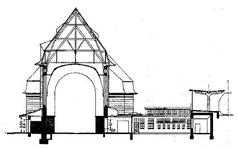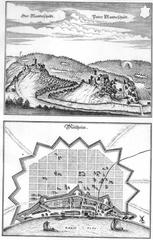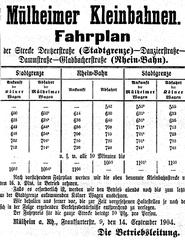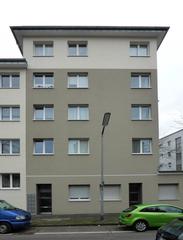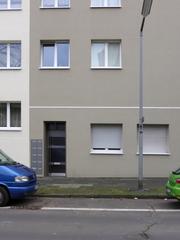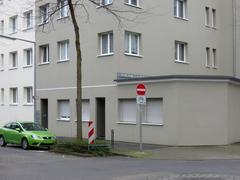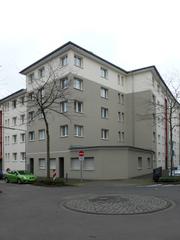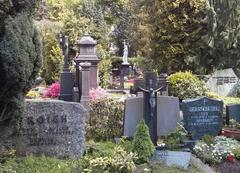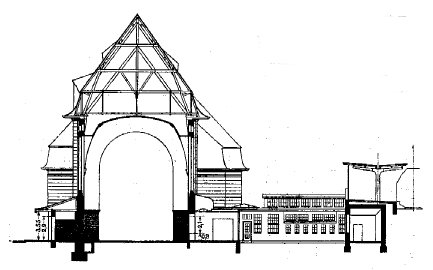
Visiting Mülheim, Cologne, Germany: Comprehensive Guide to Hours, Tickets, and Attractions
Date: 14/06/2025
Introduction: Experience Mülheim, Cologne
Mülheim, located on the right bank of the Rhine River, is one of Cologne’s most vibrant and historically significant districts. With roots tracing back to 1098, Mülheim has evolved from a medieval trading hub into a multicultural urban area renowned for its industrial heritage, creative energy, and diverse community. Visitors can expect a unique blend of historic landmarks, repurposed industrial spaces, thriving culinary scenes—especially along Keupstraße’s Turkish and Kurdish establishments—and a dynamic cultural calendar (Wikipedia, magazine.cologne-tourism.com).
This guide delivers a detailed overview of Mülheim’s rich history, key attractions, visiting hours, ticket information, accessibility, events, culinary highlights, and practical travel tips. Whether you’re exploring on foot, attending a lively festival, or sampling local cuisine, Mülheim stands out as an essential part of any Cologne itinerary.
Table of Contents
- Early Origins and Medieval Development
- Integration into Cologne and Urban Expansion
- Industrial Heritage and Urban Transformation
- Cultural Significance and Diversity
- Key Historical Landmarks & Visitor Information
- Travel Tips & Accessibility
- Modern-Day Mülheim: Urban Renewal
- Notable Figures and Legacy
- Top Attractions: Hours, Tickets, and Highlights
- Arts, Entertainment, and Events
- Culinary Experiences
- Outdoor Activities & Recreation
- Shopping & Local Crafts
- Family-Friendly Attractions
- Architectural Highlights
- Practical Visitor Tips
- Unique Experiences
- Festivals & Annual Events
- Frequently Asked Questions (FAQs)
- Summary & Next Steps
1. Early Origins and Medieval Development
First mentioned in 1098 as “Mulenheym,” Mülheim was strategically positioned along the Rhine, making it a key medieval trading post within the County of Berg. Granted town rights in 1322, Mülheim thrived as an independent urban center with its own economic privileges. The river provided essential trade links, shaping both Mülheim’s and Cologne’s development (Wikipedia, latlon-europe.com).
2. Integration into Cologne and Urban Expansion
Despite its proximity, Mülheim remained independent until 1914, when rapid industrialization and population growth prompted its incorporation into Cologne. The late 19th and early 20th centuries saw factories, railways, and residential districts emerge, transforming Mülheim into an industrial powerhouse and working-class hub (Wikipedia, latlon-europe.com).
3. Industrial Heritage and Urban Transformation
Mülheim’s industrial legacy is preserved in its architecture: red-brick factories, warehouses, and worker housing. Today, many of these buildings host theaters, galleries, tech startups, and event venues, blending historic character with creative innovation. The iconic Mülheimer Brücke, a green suspension bridge completed in the early 20th century, not only connects Mülheim to the rest of Cologne but also offers panoramic river views (magazine.cologne-tourism.com, funkygermany.com).
4. Cultural Significance and Diversity
Mülheim’s multicultural spirit is most evident along Keupstraße, renowned for its Turkish and Kurdish shops, bakeries, and eateries. The district’s diverse community is celebrated in its festivals, markets, and vibrant everyday life. Repurposed industrial spaces now house theaters, concert halls, and creative hubs, attracting artists, students, and entrepreneurs (magazine.cologne-tourism.com, local.cologne).
5. Key Historical Landmarks & Visitor Information
- Mülheimer Brücke: Open year-round, free access, ideal for scenic walks and photography.
- Keupstraße: Lively multicultural street; open daily, no admission fee.
- St. Clemens Church: Romanesque architecture, open 9:00 AM–6:00 PM, free entry (donations welcome). Guided tours available (mygermanyvacation.com).
- Former Industrial Sites: Many are now cultural venues (e.g., E-Werk, Palladium); check websites for event schedules and ticket prices.
6. Travel Tips & Accessibility
- Getting There: Mülheim is accessible via S-Bahn, regional trains (Köln-Mülheim station), and tram lines 3, 4, and 18 (Wiener Platz). Consider a day pass for unlimited travel (KVB).
- Accessibility: Most public spaces and transport are wheelchair accessible; check specific venues for details.
- Nearby Attractions: Quick transit to Cologne Cathedral, Old Town, and Rheinauhafen.
7. Modern-Day Mülheim: Urban Renewal
Today, Mülheim balances its industrial past with ongoing renewal. Wiener Platz serves as the district’s transportation and cultural hub. Repurposed spaces, new green areas, and a lively events calendar create a dynamic atmosphere for residents and visitors alike (Wikipedia).
8. Notable Figures and Legacy
Konrad Adenauer, Cologne’s influential mayor and Germany’s first post-war chancellor, is among the prominent figures linked to Mülheim’s history (funkygermany.com). The district remains a symbol of innovation, resilience, and diversity.
9. Top Attractions: Hours, Tickets, and Highlights
- Schanzenstraße: Now a creative hub with repurposed factories, media companies, and event venues. The local.cologne street market is a highlight.
- E-Werk & Palladium: Leading concert venues; opening hours vary by event; tickets online or on-site (E-Werk, Palladium).
- Mülheimer Hafen: Picturesque riverside for walks and festivals.
- Weekly Market at Wiener Platz: Saturdays 8:00 AM–2:00 PM, free entry.
10. Arts, Entertainment, and Events
Mülheim’s cultural calendar is packed with concerts, theater, festivals, and street art tours (mygermanyvacation.com). Notable annual events:
- Early Summer Design Festival at Wachsfabrik: Regional crafts, workshops, and music (rausgegangen.de).
- Jeck im Sunnesching Festival: Carnival spirit and live music.
- Rainbow Festival Köln: Diversity celebration with major acts.
- Street Art Tours: Explore murals and graffiti, especially near Schanzenstraße and Keupstraße.
11. Culinary Experiences
- Keupstraße: “Little Istanbul” offers Turkish, Kurdish, and Middle Eastern cuisine.
- Riverside Cafés & Beer Gardens: Enjoy Kölsch beer and local dishes with river views (destinationabroad.co.uk).
- Weekly Markets: Fresh produce, street food, and local specialties.
12. Outdoor Activities & Recreation
- Rhine Promenade: Walking, cycling, and picnicking along scenic river paths.
- Mülheimer Stadtgarten: Family-friendly park with playgrounds and lawns.
- Cycling Tours: Bike rentals and guided tours available (nomadicmatt.com).
13. Shopping & Local Crafts
- Independent Boutiques & Vintage Shops: Find unique fashion, jewelry, and home décor.
- Local Markets: Traditional weekly markets for fresh produce and regional goods.
14. Family-Friendly Attractions
- Mülheimer Stadtgarten: Playground, events, and open spaces for families.
- Cologne Zoo & Botanical Garden: Nearby, open daily 9:00 AM–6:00 PM (zoo ~€20 adults, ~€12 children; garden free) (Cologne Zoo, Botanical Garden Info).
15. Architectural Highlights
- Industrial Architecture: Historic brick factories now house creative industries.
- 19th-Century Townhouses: Stroll through quiet, leafy residential quarters.
16. Practical Visitor Tips
- Best Times to Visit: June–September for outdoor events and festivals; average highs 22°C (72°F) (wanderlog.com).
- Safety: Generally safe; usual urban precautions apply.
- Language: English widely spoken; basic German phrases appreciated.
17. Unique Experiences
- Food Tours: Guided tastings along Keupstraße.
- Creative Workshops: Pottery, painting, and photography in local studios.
- River Cruises: Scenic boat tours from nearby piers (mygermanyvacation.com).
18. Festivals & Annual Events
- Early Summer Design Festival: Art, crafts, and live music at Wachsfabrik.
- Jeck im Sunnesching & Rainbow Festival Köln: Carnival and diversity celebrations.
- Family & Community Festivals: Lindenthaler Familien- & Veedelsfest, Mittsommerfest.
- Music & Nightlife: Concerts at Carlswerk Victoria, Warehouse RAVE XXL, and more (songkick.com, allevents.in).
19. Frequently Asked Questions (FAQs)
Q: Is there an entrance fee to visit Mülheim?
A: No, the district is open to all. Some attractions and events may charge entry.
Q: What are the best times to visit?
A: Spring through early autumn for outdoor events and festivals.
Q: Are guided tours available?
A: Yes, walking and food tours are offered by local operators and tourism offices.
Q: Is Mülheim accessible for people with disabilities?
A: Most venues and transport are accessible; check with event organizers for specifics.
Q: How do I reach Cologne’s historic sites from Mülheim?
A: Quick transit via tram/S-Bahn from Mülheim to Cologne’s center.
20. Summary & Next Steps
Mülheim seamlessly blends medieval roots, industrial heritage, and modern multicultural vibrancy. Visitors will find iconic landmarks such as St. Clemens Church and Mülheimer Brücke, a thriving arts scene, lively markets, and authentic global cuisine. The district’s excellent transportation links, accessible venues, and festive calendar make it a compelling destination for all types of travelers.
Ready to explore?
- Download the Audiala app for curated walking tours, event tickets, and insider tips.
- Follow Cologne tourism and Audiala on social media for the latest updates and travel inspiration.
- Plan your visit using the official resources and event calendars linked below.
Useful Links
- Official Cologne Tourism
- Köln-Mülheim Station Info
- Mülheimer Brücke Event Info
- Keupstraße Cultural Events
- local.cologne street market
- E-Werk
- Palladium
- Kulturbunker Mülheim Events
- Public Transport Info (KVB)
- Cologne Zoo
- Events Calendar – rausgegangen.de
- Cologne Attractions Guide – mygermanyvacation.com
- Is Cologne Worth Visiting – destinationabroad.co.uk
- Travel Tips – nomadicmatt.com
- Cologne in June – wanderlog.com
